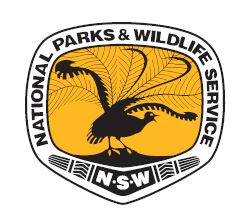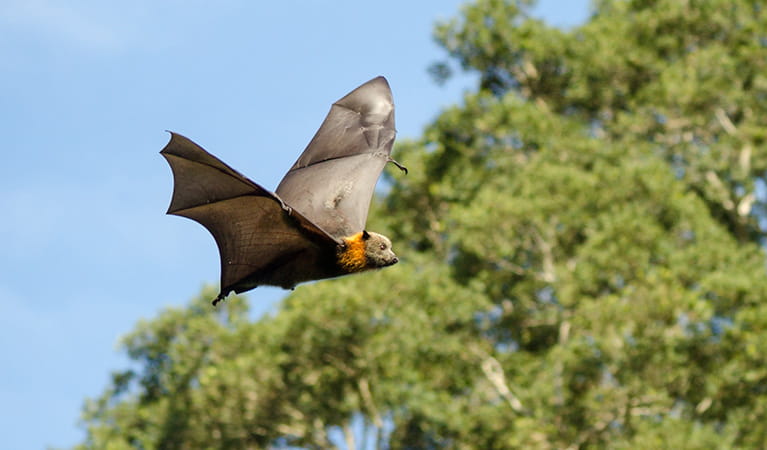Wingham Brush twilight tour
Wingham Brush Nature Reserve
Overview
Experience the magic of Wingham Brush Nature Reserve at twilight. Soak in breathtaking scenery as we meander along the boardwalk while the sun sets over a canopy of flying foxes.
- When
Wednesday 8 October 2025 and Thursday 8 January 2026.
7pm to 9pm.
- Where
- Wingham Brush Nature Reserve in North Coast
- Accessibility
- Easy
- Grade
- Easy. Suitable for adults and children 5 years and over. You’ll walk for 2km along a flat boardwalk.
- Price
-
Adult $20 per person. Child (5 to 16 years) $15 per person. Family $60 (2 adults and 2 children).
- Meeting point
- Wingham Brush boardwalk
- Bookings
- Bookings required. Phone 1300 072 757 for more information or book online.
Join our NPWS guide at ‘The Brush’. This nature reserve is a significant roosting and maternity site for the vulnerable grey-headed flying fox. Learn about this mysterious mammal as you explore the tree canopy by torchlight. You’ll discover what they eat, where they sleep and how they live in this incredibly diverse environment.
This family-friendly twilight adventure is fun for all ages. It’s a great opportunity to spot fruit pigeons, bowerbirds and bats from under the canopy of Wingham Brush. You'll be amazed at what you can discover in the landscape with a little help from your guides.
Please wear fully enclosed footwear and bring insect repellent, drinking water, snacks and a small torch to guide you.
More about grey-headed flying foxes
You can also watch a live stream of the grey-headed flying fox colony at Wingham Brush on our 'bat cam'. This footage will help rangers and scientists learn more about this threatened species to guide conservation efforts.
The grey-headed flying fox is Australia's largest bat, with a wingspan up to 1m. These ecosystem engineers are unlike other pollinators like birds and bees, they can transport pollen over long distances and disperse larger seeds, travelling up to 50km in a single trip.
These flying farmers play an important role in ensuring the regeneration, genetic diversity and survival of our native forests, especially after bushfires. Part of Wingham Brush Nature Reserve has been declared an Asset of Intergenerational Significance (AIS) to bolster the protection of this important mammal by increasing legislative protections for the habitat and species. This declaration allows for the increased ability to prioritise NPWS management and identify emerging threats, so if needed rapid intervention can take place.
Local alerts
For the latest updates on fires, closures and other alerts in this area, see https://www.nationalparks.nsw.gov.au/things-to-do/guided-tours/wingham-brush-twilight-tour/local-alerts
Operated by

- NSW National Parks & Wildlife Service
Park info
- in Wingham Brush Nature Reserve in the North Coast region
Wingham Brush Nature Reserve is always open but may have to close at times due to poor weather, flooding, or for the benefit of the flying foxes during breeding.
Visitor info
All the practical information you need to know about Wingham Brush twilight tour.
Maps and downloads
Learn more
Wingham Brush twilight tour is in Wingham Brush Nature Reserve. Here are just some of the reasons why this park is special:
Biripi country

Wingham Brush is part of the traditional lands of the Biripi people. Prior to European occupation, the Biripi people used the area to collect bush tucker, medicinal plants, and for social gatherings by the river. 'Wingan' in the local Aboriginal language means 'where bats come to drink'. Sit by the banks of the river and you might see bats and flying foxes diving into the river to quench their thirst.
Friendly flying foxes

Wingham Brush is the only known continuously occupied roosting and maternity site for the vulnerable grey-headed flying fox between Bellingen and the Hunter Valley, peaking at over 200,000 flying foxes in the warmer months. They roost by day and fly out at night to feed. Guided in the dark by excellent eyesight and sense of smell, they forage for up to 40km from their roost. Sit by the banks of the river at sunset and you'll see this spectacular sight as they fly out in search of food. Fans of other flying things will love bird watching here too You'll find over 100 bird species here, including the osprey, black-necked stork or jabiru and wompoo fruit-dove.
- Grey-headed flying-fox live cam Get a glimpse into the world of threatened grey-headed flying-foxes at Wingham Brush Nature Reserve. Watch our bat cam live stream any time from dawn to dusk.
- Wingham Brush boardwalk Wingham Brush boardwalk connects several walking tracks for a wheelchair friendly experience in the rainforest. Enjoy birdwatching and see a grey-headed flying fox roosting site.
- Wingham Brush twilight tour Experience the magic of Wingham Brush Nature Reserve at twilight. Soak in breathtaking scenery as we meander along the boardwalk while the sun sets over a canopy of flying foxes.
The Wingham Brush method

Wingham Brush was once pristine rainforest but under European settlement, the area was selectively logged, especially for red cedar. You can still see the remains of two saw pits today from the mid-1800s. Fortunately, in 1909, it became a reserve, with the historic wharf on Manning River. But by 1980, the rainforest was infested with weeds, which threatened its very survival. Thanks to the dedication of the Wingham Brush regeneration team, and what is now internationally recognised as 'The Wingham Brush method', the rainforest has since been regenerated and returned to its natural state.
Unique rainforest

Wingham Brush is an endangered rainforest community and one of the few remnants of subtropical lowland rainforest in Manning Valley. It has at least 195 species of native plants, including 76 species of trees and 32 different vines. Wander along the boardwalk and you'll see impressive trees like the gigantic Moreton Bay figs, giant stinging tree and shiny-leaved stinging tree.
Plants and animals protected in this park
Animals
-

Grey-headed flying-fox (Pteropus poliocephalus)
The grey-headed flying fox is Australia's largest native bat, with a wingspan up to 1m. This threatened species travels up and down south-eastern Australia and plays a vital role in pollinating plants and spreading seeds in our native forests.

